Topics
Category
Era
Betty Crocker
For many Americans, the name Betty Crocker evokes an image of domestic perfection. From the often-reissued Betty Crocker Picture Cookbook to the iconic red spoon logo that bears her signature, Betty Crocker is one of the most recognized names in cooking. It comes as a surprise to some that “America’s First Lady of Food” is, in fact, fictional.
Betty Crocker got her start not in the kitchen but in the advertising department of the Washburn-Crosby Company of Minneapolis. After an October 1921 contest in the Saturday Evening Post, Washburn-Crosby received many household questions along with contest entries. Samuel Gale, head of advertising, wanted to answer the questions but felt that the advice should come from a woman. Gale solved his problem by inventing Betty Crocker. Her last name was chosen to honor former company director William G. Crocker. “Betty” was chosen because it sounded cheerful and friendly.
The advertising staff began to answer consumer questions using Betty Crocker’s name and persona. The answers, provided by the all-female home service department, promoted a new kind of cooking. Betty’s answers encouraged standard pan sizes, measurements, and cooking temperatures. She gave advice about how to use new electrical appliances. And she offered homemakers nationwide the chance to receive personal advice from a kindly figure who signed each letter, “Cordially Yours, Betty Crocker.”
In 1924, the Washburn-Crosby Company bought a faltering radio station and renamed it WCCO. On October 2, the first Betty Crocker Home Service Program premiered on the station. Betty, voiced by Washburn-Crosby home economist Blanche Ingersoll, promoted good cooking as the secret to a happy home.
By the following year, The Betty Crocker Cooking School of the Air was offering listeners a chance to cook along with Betty. In twenty-seven years on the air, over one million people completed the program. By the end of 1925, the two radio programs were on the air in twelve regional markets. While different women voiced Betty in each city, they read scripts in the main Betty Crocker office in Minneapolis.
While Blanche Ingersoll provided Betty’s voice in the Twin Cities, it was another home economist, Marjorie Child Husted, who drove her persona. Husted had joined the Washburn-Crosby Company sales team in 1923. She led a team of home economists to create and triple-test recipes to meet the Betty Crocker standard. She also wrote the scripts for Betty Crocker’s radio broadcasts. Husted carefully shaped the public face of Betty Crocker. She arranged for “Betty” to interview Hollywood stars about cooking, their favorite recipes, and their home lives.
In the 1930s and 1940s, the Betty Crocker brand responded to the shifting needs of American homemakers. During the Great Depression, she offered tips for household thrift as Husted and her staff worked to create low-cost recipes that would stretch food budgets. During World War II, she advertised recipes for rationing and encouraged patriotic work on the home front. In 1945, Fortune magazine declared Betty Crocker the second most popular woman in America.
Also during the war, Husted worried that women were not being honored for their work in the home. She developed the Betty Crocker American Home Legion in 1944 to recognize women for their contributions. Husted championed the rights of women in the workplace, criticizing General Mills and other companies for discriminating against their female employees.
The 1950s brought changes for Betty Crocker. The step-by-step instructions of the Betty Crocker Picture Cookbook (1950) helped make it a best seller. In 1954, General Mills introduced Betty Crocker’s red spoon logo that gave cookbooks, cake mixes, and other items the Betty seal of approval. In 1958, the Betty Crocker Test Kitchens moved from Minneapolis to General Mills’ headquarters in Golden Valley. Tour guides often found themselves consoling guests who had been shocked to find that their cooking heroine wasn't real.
Betty Crocker’s popularity waned in the later decades of the twentieth century. However, cookbooks, recipes, and products bearing her logo, signature, and portrait continued to be produced. In 1996, a new Betty Crocker portrait was made by blending the faces of seventy-five contest winners with the previous portrait to create a Betty for the next century.
Bibliography
General Mills: 75 Years of innovation invention food & fun. Minneapolis: General Mills, 2003.
“General Mills History of Innovation: the history of Betty Crocker.”
http://generalmills.com/~/media/Files/history/hist_betty.ashx
Marks, Susan. Finding Betty Crocker: The Secret Life of America’s First Lady of Food. New York: Simon & Schuster, 2005.
Marling, Karal Ann. As Seen on TV: The Visual Culture of Everyday Life in the 1950s. Cambridge: Harvard University Press, 1994.
Stuart, Bonnye E. More Than Petticoats: Remarkable Minnesota Women. Guilford, CT: TwoDot, 2004.
Related Resources
Primary
Crocker, Betty. Betty Crocker Chiffon Cake Recipes and Secrets. [Minneapolis]: General Mills Inc., 1948.
——— . Betty Crocker Cook Book of All-purpose Baking: 220 of the Best Tested Recipes from the Thousands in the Gold Medal File. [Minneapolis]: General Mills Inc., 1942.
——— . Betty Crocker’s All-time Favorites. New York: Golden Press, 1971.
——— . Betty Crocker’s Dinner for Two: Cook Book. New York: Simon and Schuster, 1958.
——— . Betty Crocker’s Picture Cook Book. Minneapolis: General Mills, 1950.
——— . Betty Crocker’s 101 Delicious Bisquick Creations: As Made and Served by Well-known Gracious Hostesses, Famous Chefs, Distinguished Epicures and Smart Luminaries of Movieland. [Minneapolis]: General Mills Inc., 1933.
——— . Family Dinners in a Hurry. New York: Golden Press, 1970.
——— . Let the Stars Show You How to Take a Trick a Day with Bisquick. [Minneapolis]: General Mills Inc., 1935.
Leslie L. Anderson and Family Papers, 1883–1981
Manuscript Collection, Minnesota Historical Society, St. Paul
Description: Contains papers of Ruth G. Anderson that describe her time working in the General Mills Test Kitchens in the 1930s, 40s, and 50s.
OH99
Oral History interview with Marcia Copeland, August 6, 2002
Oral History Collection, Minnesota Historical Society, St. Paul
http://collections.mnhs.org/cms/display.php?irn=10448001
Description: Copeland discusses her career with General Mills and time as director of the Betty Crocker Kitchens.
OH99
Oral History Interview with Ralcie Ceass, September 19, 2002
Oral History Collection, Minnesota Historical Society, St. Paul
http://collections.mnhs.org/cms/display.php?irn=10448018
Description: Ceass discusses her career with General Mills, time working in the Betty Crocker Kitchens, and being the director of the General Mills Camera Kitchen.
OH99
Oral History Interview with Barbara Jo Davis, September 17, 2002
Oral History Collection, Minnesota Historical Society, St. Paul
http://collections.mnhs.org/cms/display.php?irn=10448017
Description: Davis describes her twenty year career in the Betty Crocker Kitchens and her childhood ambitions to be Betty Crocker.
Secondary
Danbom, David B. “Flour Power: The Significance of Flour Milling at the Falls.” Minnesota History 58, no. 5/6 (Spring/Summer 2003): 270–285.
http://collections.mnhs.org/mnhistorymagazine/articles/58/v58i05-06p270-285.pdf
Ehrlick, Darrell. It Happened in Minnesota. Guilford, CT: TwoDot, 2008.
Gray, James. Business without Boundary: The Story of General Mills. Minneapolis: University of Minnesota Press, 1954.
Harris, Moira F. “Ho-ho-ho! It Bears Repeating: Advertising Characters in the Land of Sky Blue Waters.” Minnesota History 57, no. 1 (Spring 2000): 23–35.
http://collections.mnhs.org/mnhistorymagazine/articles/57/v57i01p023-035.pdf
Horner, Jennifer R. “Betty Crocker’s Picture Cookbook: A Gendered Ritual Response to Social Crises of the Postwar Era.” Journal of Communication Inquiry 24, no. 3 (July 2000): 332–345.
Marks-Kerst, Susan. “Betty Crocker: Marketing the Modern Woman.” Hennepin History 58, no. 2 (Spring 1999): 4–19.
Roberts, Kate, and Barbara Caron. “’To the markets of the world’: advertising in the Mill City, 1880-1930.” Minnesota History 58, no. 5/6 (Spring/Summer 2003): 308–319.
http://collections.mnhs.org/mnhistorymagazine/articles/58/v58i05-06p308-319.pdf
Web
Betty Crocker. The Betty Crocker Kitchens.
http://www.bettycrocker.com/betty-crocker-kitchens
Related Audio
MN90: WCCO - How Betty Crocker Became a Good Neighbor
All rights reserved
Holding Location
More Information
Articles
MN90: The Invention of Betty Crocker
Betty Crocker has it all. She’s wholesome, pretty, and bakes a “perfect cake every time.” Pretty impressive for a woman who doesn’t actually exist. MN90 Producer Andi McDaniel finds out how Gold Medal Flour created a persona that still charms homemakers today.
All rights reserved
Holding Location
More Information
Articles
MN90: WCCO - How Betty Crocker Became a Good Neighbor
All rights reserved
Holding Location
More Information
Articles
MN90: The Invention of Betty Crocker
Betty Crocker has it all. She’s wholesome, pretty, and bakes a “perfect cake every time.” Pretty impressive for a woman who doesn’t actually exist. MN90 Producer Andi McDaniel finds out how Gold Medal Flour created a persona that still charms homemakers today.
All rights reserved
Holding Location
More Information
Articles
MN90: WCCO - How Betty Crocker Became a Good Neighbor
All rights reserved
Holding Location
More Information
Articles
Related Images
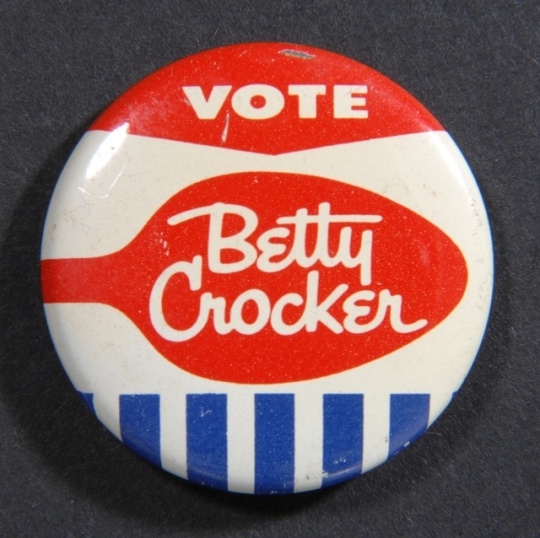
“Vote Betty Crocker” pin
All rights reserved
Holding Location
Articles
More Information
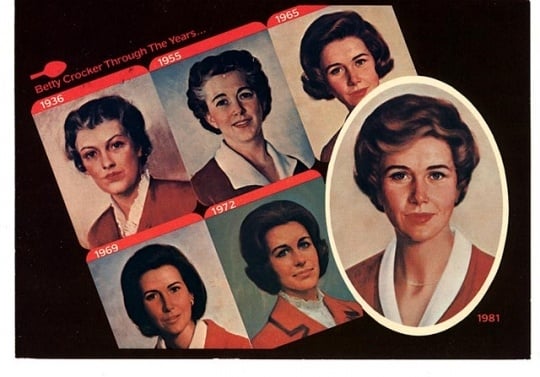
Betty Crocker through the years
Holding Location
More Information

Gold Medal Flour and WCCO sign
All rights reserved
Holding Location
Articles
More Information
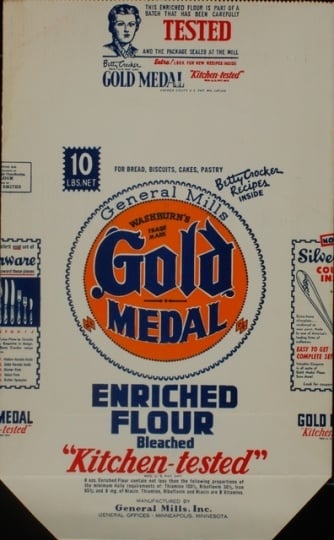
Gold Medal Flour Bag
All rights reserved
Holding Location
Articles
More Information
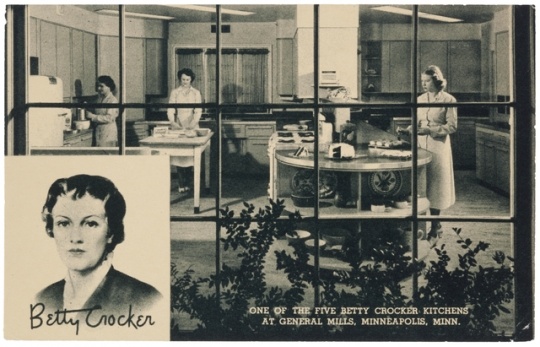
Betty Crocker Test Kitchens
Holding Location
Articles
More Information
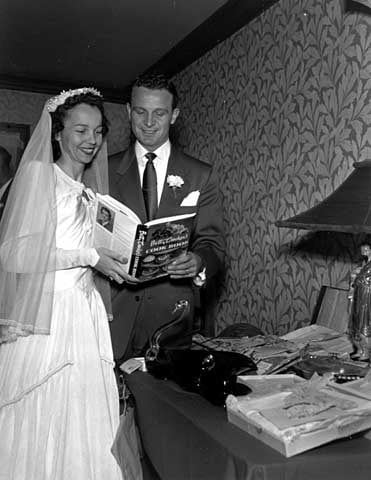
A bride and groom read a Betty Crocker cook book
Wedding in the family of Mr. and Mrs. Frank Uram; bride and groom at gift table looking at Betty Crocker cook book, 1950. Photograph by Lee Brothers.
Holding Location
Articles
More Information

“Vote Betty Crocker” pin
All rights reserved
Holding Location
Articles
More Information

Betty Crocker through the years
Holding Location
More Information

Gold Medal Flour and WCCO sign
All rights reserved
Holding Location
Articles
More Information

Gold Medal Flour Bag
All rights reserved
Holding Location
Articles
More Information

Betty Crocker Test Kitchens
Holding Location
Articles
More Information

A bride and groom read a Betty Crocker cook book
Wedding in the family of Mr. and Mrs. Frank Uram; bride and groom at gift table looking at Betty Crocker cook book, 1950. Photograph by Lee Brothers.
Holding Location
Articles
More Information

“Vote Betty Crocker” pin
All rights reserved
Holding Location
Articles
More Information
Related Articles
Turning Point
In 1921, following a flood of requests for household advice, the Washburn Crosby Company advertising department creates the persona of Betty Crocker to answer consumer questions and promote the company’s Gold Medal Flour.
Chronology
1921
1924
1925
1928
1931
1936
1944
1950
1954
1958
1985
1996
Bibliography
General Mills: 75 Years of innovation invention food & fun. Minneapolis: General Mills, 2003.
“General Mills History of Innovation: the history of Betty Crocker.”
http://generalmills.com/~/media/Files/history/hist_betty.ashx
Marks, Susan. Finding Betty Crocker: The Secret Life of America’s First Lady of Food. New York: Simon & Schuster, 2005.
Marling, Karal Ann. As Seen on TV: The Visual Culture of Everyday Life in the 1950s. Cambridge: Harvard University Press, 1994.
Stuart, Bonnye E. More Than Petticoats: Remarkable Minnesota Women. Guilford, CT: TwoDot, 2004.
Related Resources
Primary
Crocker, Betty. Betty Crocker Chiffon Cake Recipes and Secrets. [Minneapolis]: General Mills Inc., 1948.
——— . Betty Crocker Cook Book of All-purpose Baking: 220 of the Best Tested Recipes from the Thousands in the Gold Medal File. [Minneapolis]: General Mills Inc., 1942.
——— . Betty Crocker’s All-time Favorites. New York: Golden Press, 1971.
——— . Betty Crocker’s Dinner for Two: Cook Book. New York: Simon and Schuster, 1958.
——— . Betty Crocker’s Picture Cook Book. Minneapolis: General Mills, 1950.
——— . Betty Crocker’s 101 Delicious Bisquick Creations: As Made and Served by Well-known Gracious Hostesses, Famous Chefs, Distinguished Epicures and Smart Luminaries of Movieland. [Minneapolis]: General Mills Inc., 1933.
——— . Family Dinners in a Hurry. New York: Golden Press, 1970.
——— . Let the Stars Show You How to Take a Trick a Day with Bisquick. [Minneapolis]: General Mills Inc., 1935.
Leslie L. Anderson and Family Papers, 1883–1981
Manuscript Collection, Minnesota Historical Society, St. Paul
Description: Contains papers of Ruth G. Anderson that describe her time working in the General Mills Test Kitchens in the 1930s, 40s, and 50s.
OH99
Oral History interview with Marcia Copeland, August 6, 2002
Oral History Collection, Minnesota Historical Society, St. Paul
http://collections.mnhs.org/cms/display.php?irn=10448001
Description: Copeland discusses her career with General Mills and time as director of the Betty Crocker Kitchens.
OH99
Oral History Interview with Ralcie Ceass, September 19, 2002
Oral History Collection, Minnesota Historical Society, St. Paul
http://collections.mnhs.org/cms/display.php?irn=10448018
Description: Ceass discusses her career with General Mills, time working in the Betty Crocker Kitchens, and being the director of the General Mills Camera Kitchen.
OH99
Oral History Interview with Barbara Jo Davis, September 17, 2002
Oral History Collection, Minnesota Historical Society, St. Paul
http://collections.mnhs.org/cms/display.php?irn=10448017
Description: Davis describes her twenty year career in the Betty Crocker Kitchens and her childhood ambitions to be Betty Crocker.
Secondary
Danbom, David B. “Flour Power: The Significance of Flour Milling at the Falls.” Minnesota History 58, no. 5/6 (Spring/Summer 2003): 270–285.
http://collections.mnhs.org/mnhistorymagazine/articles/58/v58i05-06p270-285.pdf
Ehrlick, Darrell. It Happened in Minnesota. Guilford, CT: TwoDot, 2008.
Gray, James. Business without Boundary: The Story of General Mills. Minneapolis: University of Minnesota Press, 1954.
Harris, Moira F. “Ho-ho-ho! It Bears Repeating: Advertising Characters in the Land of Sky Blue Waters.” Minnesota History 57, no. 1 (Spring 2000): 23–35.
http://collections.mnhs.org/mnhistorymagazine/articles/57/v57i01p023-035.pdf
Horner, Jennifer R. “Betty Crocker’s Picture Cookbook: A Gendered Ritual Response to Social Crises of the Postwar Era.” Journal of Communication Inquiry 24, no. 3 (July 2000): 332–345.
Marks-Kerst, Susan. “Betty Crocker: Marketing the Modern Woman.” Hennepin History 58, no. 2 (Spring 1999): 4–19.
Roberts, Kate, and Barbara Caron. “’To the markets of the world’: advertising in the Mill City, 1880-1930.” Minnesota History 58, no. 5/6 (Spring/Summer 2003): 308–319.
http://collections.mnhs.org/mnhistorymagazine/articles/58/v58i05-06p308-319.pdf
Web
Betty Crocker. The Betty Crocker Kitchens.
http://www.bettycrocker.com/betty-crocker-kitchens







